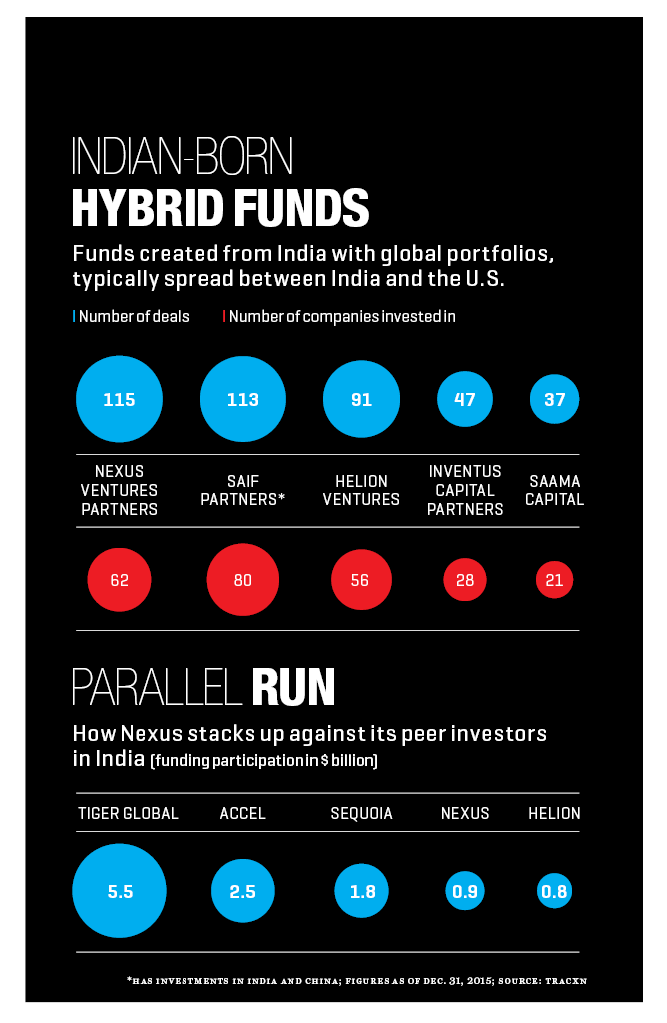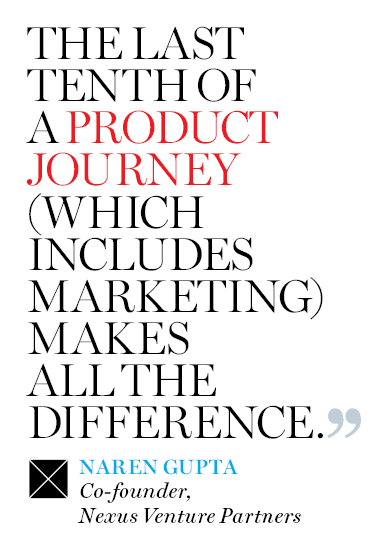The year was 2008. Naren Gupta, who had co-founded Nexus Venture Partners two years earlier, half expected a question that he had grown used to: Why are you doing this now? This time the query came from someone he was hiring—Jishnu Bhattacharjee, an IIT Kharagpur and Stanford MBA grad, aged 30. The curiosity wasn’t misplaced: At 60, Gupta was a senior citizen in the yuppyish world of startups.
A star at academics—he had a degree and a gold medal from IIT Delhi, an MS from Caltech, and a Ph.D. from Stanford University—Gupta had built a stellar career, including 15 years as co-founder and chief executive of software firm Integrated Systems, which made him one of the wealthiest Indian-Americans in Silicon Valley. He was first asked the question in late 2005 at a meeting of limited partners (LPs) when he broached the concept of a venture capital fund built on a unique premise—from day one, the fund would invest only in companies that harnessed a common theme: the global Indian.
Product startups from India that could go global would be the first type of venture to qualify for investments. The second would be product startups in the Valley that looked at India as an engineering base. “We have to make some investments in U.S. companies because we can learn from them tremendously,” Gupta told the LPs. The third type of venture would include startups that would create an online ecosystem in India, akin to the developed digital markets in the West. This last category was the riskiest because at that time India did not have smartphones, Internet access was limited, and brick-and-mortar retail ruled the roost. Gupta’s big idea: The same fund would simultaneously back two markets—India and the U.S.—as opposed to the one-fund-one-geography norm.

What Gupta was essentially asking the LPs to buy into was his track record in enterprise software and technologies. At Integrated Systems, he commercialised an operating system to run applications in aircraft, automobiles, cameras, and medical devices. During his stint as CEO, he oversaw an IPO and a merger with Wind River Systems, on whose board he stayed until Intel acquired it in 2009. He is a software entrepreneur with a standout trait: He understands product. But he is also a builder, consolidator, and wise man on the board.
Then there was his network in India. His co-founders at Nexus, for instance, were Mumbai-based Suvir Sujan and Sandeep Singhal, who had a deep understanding of the country, which in 2005 was a relative wasteland for tech entrepreneurs. Sujan had co-founded India’s first major online marketplace Baazee, which he sold to eBay in 2004. Singhal had started a health-care outsourcing venture, Medusind Solutions, and led investments for eVentures, one of India’s first breed of VCs, in companies such as MakeMyTrip.
Nexus started operations in December 2006, with headquarters in Menlo Park. Its first fund, to the tune of $100 million (Rs 631.7 crore at current rates), was floated in July 2007. Since then, it has invested in 71 ventures (disclosed), deploying $934 million as of December 2015, according to startups database Tracxn. It has clocked eight exits, mostly in enterprise (B2B) products. In the domestic consumer Internet space, OLX has been its most notable exit. It also has stakes in companies such as ShopClues, Snapdeal, and Housing, which have a longer maturity period of 10 years to 15 years.
“We are the only fund which is India-focussed and also invests in the U.S.,” says Bhattacharjee, now the company’s managing director. “Our [expertise] is around how to invest in Indian-origin companies, whether in India or globally.” All the partners are conditioned to work for two markets, India and the U.S. “Everybody needs to understand what ‘India’ really means. That’s missing in many other models,” he says, alluding to VCs which have separate offices for each market.
When choosing investable ventures in India, two simple questions serve as Gupta’s touchstone: Does it provide a solution for large-scale use and can it grab allied market opportunities? Product is a global game. In the Indian market, 90% of chief information officers buy global products. “Anything you build in India has to be globally competitive. Otherwise, the better product from the U.S. will eat your lunch even in India,” says Bhattacharjee.
Gupta says Indian product companies often stumble when it comes to marketing. “In 2006, they didn’t understand the markets they wanted to tap. They could build the technology, but didn’t know the market nuances. The last tenth of a product journey makes all the difference. Unless you get it right, the product won’t sell.”
Nexus has been instrumental in finding new-age companies such as Zynga (gaming) and GoDaddy (web hosting) as customers for its portfolio companies like Gluster (cloud storage), which Red Hat bought out. Bhattacharjee says sitting in the U.S. helps him get the perspective of enterprise customers and grasp the shifts in technology.

Jishnu Bhattacharjee, Sameer Brij Verma, and Suvir Sujan
This brings us to the challenge of shrinking technology cycles. For products in hypercompetitive businesses, dominated by, say, a Skype or a WhatsApp, the window is narrow. “If you don’t win, you get left behind,” Gupta says. “We are never going to be as fast as companies in the Valley.” Therefore, only certain kinds of product companies can be built out of India.
Traditionally, the other barrier to Indian product companies has been the lack of risk-taking. “India has a culture where you want businesses to be profitable from day one, which is possible in IT services companies. Often, the thinking among founders is, ‘We will become like employees if we raise capital’,” Gupta says. Nexus had to invest time to convince founders that they can grow faster and bigger if they had access to capital.
The effort has paid off. By December 2015, Nexus had closed its fourth fund, grossing over $1 billion in size over a decade. It is easily the largest of its kind, dwarfing funds such as the $755 million Helion Ventures, which was set up in 2006, and the $158 million Inventus Capital Partners, which was set up in 2007. Overall, it is placed third among VCs, after the Indian arms of Accel Partners ($2.5 billion) and Sequoia Capital ($1.8 billion).
PARTNERS AND INVESTEES say Nexus’s approach has a clear imprint of Gupta’s personality. He is something of a buddy to the entrepreneurs he backs. He comes well prepared for board meetings and tells other members that a CEO should not be expected to repeat what has already been circulated in the pre-meeting briefing. He wants meetings to be more about discussions rather than founders merely updating the board on last quarter’s news. “Naren drives the entrepreneur to take ownership of every issue from the point of view of different stakeholders,” rather than dictating what to do, says Bhattacharjee, who is one the board of mobile video advertisement network Vdopia with Gupta.
“He is more patient than other investors and doesn’t spend time on operational details. It helps that he is very fast with numbers,” adds Bhattacharjee. Gupta is known to multiply four-digit numbers without using a calculator, or pen and paper.
Sanjay Parthasarathy, co-founder and CEO of Indix (a database that retailers use to make data-driven decisions), says Gupta shares his thoughts openly, but there’s no pressure to take his advice. “Naren introduces us to companies he feels we can learn from. That’s very important since we are pioneering new ground on several fronts.”
Jaspreet Singh, co-founder and CEO of cloud company Druva, has been a beneficiary of both Nexus and Sequoia. “Nexus has the advantage of being in the Indo-U.S. corridor, which brings in a lot of local expertise for us on both sides,” he says. In the U.S., Nexus’s partners helped Druva in operations and marketing, and even getting financial expertise, after Singh moved there in 2010. “They often test us on whether we are in the right business in the right way.”
More important, Gupta as a mentor is a tempering influence in a world that seems to be on a permanent adrenaline rush. Notwithstanding his advocacy of venture funding, there is a strong streak of conservatism in the man who has spent all his working life within five miles of Stanford in Palo Alto. (Famously, Nexus didn’t participate in Flipkart and Ola, but more on that later.)
“Naren has maintained from the start that more companies get killed with more capital than less capital,” says Sujan. He also asks early-stage startups to be in stealth mode rather than run after publicity and media coverage.

A few investments broke out of this careful curation: most notably Housing. Nexus thought it had spotted an exceptional product entrepreneur in Rahul Yadav. It was also egged on by the surge in investors in all manner of startups, triggering what is now mocked as FoMo or the fear of missing out.
The average capital flow into ventures from India between 2010 and 2014 was nearly $914 million per year. In 2015, the aggressive entry of Softbank—Tiger Global and DST Global were already present in Flipkart—marked the onset of big-ticket funding in companies like Housing, Oyo, and Snapdeal. There was also a funding glut in a whole host of smaller companies across sectors—such as TinyOwl, a food delivery company Nexus invested in, which had to scale down operations after aggressive expansion.
The market had turned euphoric, even though customers for hyperfunded startups were not growing at the same clip. “The environment rewarded growth—fast growth,” Sujan says. “The thinking became: How do I make sure that I am not extinct? I need to grow as fast as I can so that I can raise more capital, get talent from MNCs and top campuses, then grow some more.” Singhal adds that the euphoria affected every investor and entrepreneur. When a venture didn’t grow fast enough, it turned to discounts. “That became the primary way to compete in fear of irrelevance.”
To its credit, Nexus did not overexpose itself. According to Venture Intelligence, it has invested $237 million in 43 e-commerce deals, compared to leaders Accel’s $366 million across 88 deals and Sequoia’s $420 million across 65 deals as of December 2015.
Gupta’s grasp of enterprise product helped Nexus choose companies from India that went global, with founders moving office after testing the market in and from India via cloud. A recent example is Indix, whose CEO, Parthasarathy, moved to Seattle last year. There are more than 30 such companies in Nexus’s portfolio, which are earning revenue in the U.S.
The model that Nexus and its peers (see graphic) have adopted is in a nascent stage because in India the idea of e-commerce itself is still evolving. Of the dollars deployed in the three types of companies Nexus had envisaged, companies built in the U.S. by Indian-origin founders (such as Gluster) have a 20% share, while 29% is invested in ventures born in India that have gone global (such as Eka Software for commodity trading). Domestic investments consisting of online companies and on-demand startups have a 51% share.
Early on, Gupta, Sujan, and Singhal read many things right. Some of them are clichés now. Exhibit A: India is an English-speaking tech powerhouse with bright young minds. The language unites engineers from India with the U.S., just as it does for the U.S. and Israel. “They [Indian software engineers] have lived in the U.S. and worked in American companies, and are globally aware,” Sujan is said to have told LPs. “The guy who sat in San Jose or Redmond and said ‘I want to start a company’ can now start a company here if there is risk capital available. And he can build the same product cheaper.”
The other trend they spotted was reverse migration. A decade ago, there was no evidence to show in terms of ventures, but many professionals were returning to India. “What we caught was human capital for smart technologies in critical mass. There was cutting-edge work happening from India, not just back-office work,” says Sujan.
An equation he created back in 2005 encapsulates Nexus’s thesis: India = Israel + China, where Israel, an English-speaking hub of engineers for the U.S., represents innovation potential, while China represents the local market potential owing to its comparably huge consumer base. These two factors are key to Indian product ventures becoming competitive.
Faith in the equation has its limits, as the founders of Ola and Flipkart discovered. While the cab aggregator is valued north of $5 billion now, Flipkart was, until recently, estimated to be in the $15 billion range. Nexus turned down both, and Gupta, Sujan, and Singhal stand by their position. “We didn’t do Ola primarily for regulatory risks, though Bhavish [Aggarwal] has built a great business by proving on-demand convenience,” says Singhal.

In 2008, shortly after Bhattacharjee joined Nexus’s Valley office, he travelled to Bengaluru where he met Flipkart CEO Sachin Bansal on a bicycle. “The Bansals were biking to bookshops,” he recalls. Flipkart’s apartment-cum-godown could store only 25% of the books in demand on its website. Sachin and Binny would buy the rest from bookstores on their bikes. “Every time Suvir [Sujan] gave them a term sheet, it was 50% or lower than their best offer,” Bhattacharjee recalls. By then, Tiger Global was in the reckoning for a big round. By Nexus’s reading, Flipkart was worth between $16 million and $20 million. Tiger closed it at $45 million.
But there was a catch: Flipkart then followed an inventory-led model, and Sujan’s reading was that marketplaces were the models of the future because they would be capital-light. He was right—Flipkart soon abandoned inventory for marketplace. Snapdeal too shifted from a deals model to the marketplace model.
Singhal points to the shift in Indian e-commerce over the past 18 months: “Until 2010, the core of e-commerce was about ease of shopping. Thereafter, entrepreneurs got caught in building GMV (gross merchandise value) through discounting. This led users to believe that e-commerce meant deals and discounts.” Now, companies have gone into cash-conservation mode—reducing discounts, cutting down the number of cities they are present in, laying off employees. They are trying to figure out what they stand for in the eyes of the customer.
Nexus stresses that entrepreneurs across consumer Internet sectors should spend on building assets—such as brand and technology—and do it wisely. “It is not only about price,” says Singhal, who believes the user base will grow when the product or website improves its day-to-day usage. Sujan’s motto is rather clinical: “Build, measure, build, measure.” But both feel the euphoria of 2015 and the subsequent chastening experience were much-needed learning for entrepreneurs.
Gupta’s own reading: If you are confident about creating a company of value, market sentiment doesn’t matter. “But it is better to start when the economy is in a bad shape because there is less competition. When there is euphoria, everybody gets funded and there is no environment to experiment [as one has to go with the popular model].”
Back in 2008, though, when Bhattacharjee had posed the “why now” question, Gupta’s response had nothing to do with the art of timing. “I still have to buy shoes for my kids,” he said, “and I would love to pay to go to work with smart people.”










Leave a Comment
Your email address will not be published. Required field are marked*